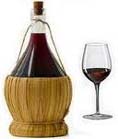Plates - 4
from Italian Traditional Food
Coalport plates
Check out these great Italian ideas at Amazon for Italian food and kitchen ideas.
<< Previous Page 4 Next>>
Continuing the potted history of plates
....
Coalport
Another interesting history in the development of plates is that of Coalport, which really began in the mid-eighteenth century at a place called
Caughley, where pottery was being made on the estate of one Squire Browne. After the Squire's death, the factory
passed into other hands, and one of the partners was a man named Thomas Turner. Turner had learned his trade at the
great Worcester porcelain factory and continued the business at Caughley.
In 1780, he took himself to Paris to find out all he could about
the making of French porcelain and it is said he brought back with him the secret of dark blue. This colour then
began to appear on a large range of wares from his and the other early factories.
He also imported skilled French workmen and artists and, about
this time, an apprentice called John Rose left to set up his own business across the river Severn at Coalport. He
did so well that, when Turner retired in 1789, he sold out to his rival - and former trainee.
For some time, Rose continued to produce pottery from both
factories, often transporting the plates across the river by barge from Caughley to Coalport for decoration. Sadly,
many of his best artists lost their lives in a storm in the October of 1799, when the ferry boat overturned. But by
1814 most of the production had been transferred entirely to Coalport.
More developments
In the early 1820's, John Rose took over the works at Swansea,
bringing the famous decorator Billingsley to work for him. The factory continued to prosper and Rose spent a great
deal of money in perfecting the turquoise colour used on so much Sevres porcelain. Finally, his son imitated this
and other characteristics of Sevres so well that his porcelain is impossible to distinguish from the
original.
Coalport plates of this period are elaborately decorated in
"revived rococo", with lavishly painted fruit and flowers, much gilding, and turquoise and deep rose colours.
Elaborate sets, using dark blue and gold on white, were produced in the style of Worcester, and fine porcelain
after the style of Chelsea.
In fact, the Coalport factory later added the famed "Red Anchor"
and "Raised Anchor" Chelsea marks (1750-1770) to its own copies of the earlier porcelain, and the marks themselves
were repeated again on later bone china, copies of Coalport's wares.
In 1843, Rose's nephew, William Frederick, took over the
management of the factory and was even invited to Sevres in 1855, after winning a French gold medal, a compliment
indeed from the factory whose ideas had been so cleverly plagiarised.
Page 5 of this Italian Traditional Food
article plates can be found on the next page.
<<
Previous Page 4
Next>>

Copyright © 2009 -
. All Rights Reserved Worldwide. Italian Traditional Food
You may not reprint articles from this website
without the written permission of the site owner.
Disclaimer: Articles on this
Website are provided for information purposes only. Italiantraditionalfood.com does not accept any responsibility
or liability for the use or misuse of the article content on this site or reliance by any person on the site's
contents.
| 


 Digg
Digg Stumbleupon
Stumbleupon Google Bookmarks
Google Bookmarks Delicious
Delicious Twitter
Twitter Facebook
Facebook Yahoo My Web
Yahoo My Web Reddit
Reddit